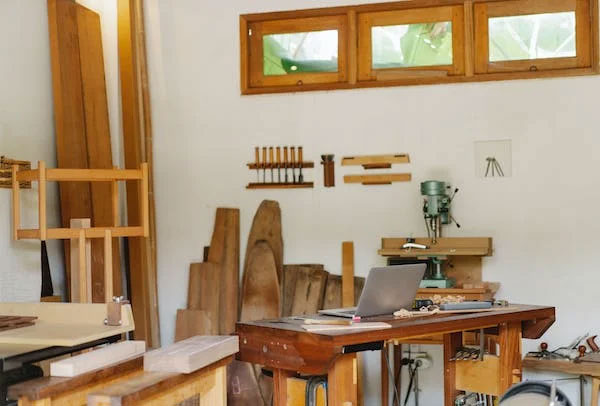Think about the desk you’re sitting at or the shelves on your wall. Chances are, they are made of manufactured wood. This material isn’t just popular because it’s versatile and affordable—it’s also an eco-friendly superstar. But what exactly is manufactured wood, and how does it differ from the lumber you see in a forest? Let’s dive in!
What is Manufactured Wood
Manufactured wood, composed of elements like sawdust, wood chips, or fibers, is a modern engineering marvel. It stands as a testament to human ingenuity, not just an alternative to traditional wood.
Combining these small wood elements using careful processes and specific technological procedures allows us to create a kind of ‘customized’ wood that can meet the diverse demands of today’s world, whether that’s strength, affordability, or even a particular form factor or look.
Imagine the possibilities: wood is no longer bound by the definitions of nature. Instead, we can refine and construct it to fulfill a broader range of applications in construction, furniture design, and more. It’s wood but on our terms.
This revolution in material science is driving the manufactured wood industry forward, providing consumers and businesses with robust, reliable, and efficient materials that stay true to the natural essence of wood but with significant added benefits.
Raw Materials: What Goes In
Without raw materials, there would be no manufactured wood. These are typically leftovers from other wood processes—think of them as the bits that would otherwise be wasted. Recycling these parts lets us get the most out of each tree and reduce waste.
It’s essential to understand that these raw materials are a varied lot. Not only do they come from different types of trees, but they can take on diverse forms as well. These can range from larger chunks, such as chips or shavings, to finer particles, like sawdust.
Sometimes, even the bark, considered non-usable for other products, gets recycled into the mix, ensuring every part of the tree finds a purpose.
Moreover, many of these materials are sourced from managed forests or plantations where trees are grown specifically for these purposes.
The Manufacturing Process
Creating manufactured wood is a bit like baking—you need the right mix of ingredients and a good process. Here’s how it goes:
1. Getting the Pieces Ready
After cleaning and breaking down incoming wood materials, the next critical step is ensuring they’re adequately dried. Why is this so important? Too much moisture can ruin the bonding process essential for creating robust and sturdy manufactured wood.
2. Creating the Core of Manufactured Wood
Next, we mix these dry pieces with adhesives and chemicals – like the glue that holds everything together. We carefully choose these materials for their ability to bind and create a solid final product. We’ll adjust the mix depending on what we’re making, such as plywood or particle board.
3. Adding Heat and Pressure
We then apply heat and pressure – it’s like pressing a giant sandwich in a panini press. This step fuses everything into a dense, solid sheet ready for the real world.
4. The Finishing Touches
Once cooled and set, we trim and sand the boards for a smooth, perfect finish. Quality control is a big deal; we check each piece to ensure it’s up to the high standards expected by customers and regulations.
The Role of Adhesives in Manufactured Wood
Without the proper adhesives, manufactured wood would fall apart. These glues are tailored to hold under stress and stay strong for a long time. The crucial role of adhesives in manufactured wood cannot be underestimated.
Like a firm handshake or a binding commitment, adhesives seal the bond between the disparate pieces of wood, offering the resilience and hardiness that manufactured wood is known for.
These ‘bonding heroes’ are designed to withstand pressures and stresses from all directions, strengthening each piece of manufactured wood. They bridge the gaps, fill in the crevices, and glue everything together, ensuring that the final product exceeds the sum of its parts.
However, it isn’t only about being robust – in today’s world, the fight for sustainability is ongoing, and every sector plays its part. The journey for greener alternatives continuously propels forward in the realm of adhesives. We constantly strive to explore and incorporate biodegradable and less toxic adhesives into our manufacturing process.
Innovation in green adhesives helps reduce the overall environmental impact of manufactured wood, pushing the industry towards a future where products are solid and affordable and embody the principles of ecological responsibility.
The Finishing Process
1. Sanding and Cutting
Precision is critical in the final stages, where large sheets of composite wood are sanded down to eliminate any roughness and then cut into usable sizes. The equipment is state-of-the-art, ensuring every piece meets the exact specifications.
2. Coating and Sealing
Finally, the boards may be coated or sealed for more durability and resistance to the elements. These additional treatments can help manufactured wood fend off moisture, pests, and even fire, making it a safe choice for various uses.
3. Environmental Considerations and Certification
Sustainability isn’t just a buzzword in the manufactured wood industry; it’s a commitment. We follow strict sustainable practices in production, and you should look for certifications like FSC or SFI when buying to ensure you get products from responsible sources. Thanks to these efforts, manufactured wood is high quality and eco-conscious.
4. Advantages of Manufactured Wood Products
When it comes to cost, flexibility in use, and reliable quality, manufactured wood checks all the boxes. It can be used in many settings, from home construction to creating beautiful furniture.
Common Uses of Manufactured Wood
From the beams in your home to the sleek coffee table in your living room, manufactured wood comes in many forms. The industry constantly finds new and innovative ways to use this versatile material, proving its vital role in modern architecture and interior design. The versatile nature of manufactured wood offers aesthetic pleasure and ensures functionality and durability where it matters most.Manufactured wood’s versatility extends well beyond the visible structures in our homes, given its flexible workability and design-friendly nature.
Listed below are some uses you may not have considered.
- Cabinetry and Shelving: Strong and highly customizable, manufactured wood can be shaped into intricate designs, becoming indispensable in creating kitchen cabinets, bookshelves, and closet organizers.
- Flooring: Manufactured wood is also a dominant player in the floorboard industry. Engineered wood flooring, for example, showcases an exquisite surface layer of natural wood while relying on underlying layers of manufactured wood for stability.
- Decorative Accents and Furnishings: The aesthetic appeal of manufactured wood is leveraged in large furniture and decorative accents around homes and offices. From picture frames to paneling, it adds warmth and character to spaces.
- Industrial Packaging: This might surprise you, but manufactured wood is a common material used in industrial packaging, providing a robust platform to transport goods while being more economically and ecologically sustainable than some other packaging materials.
- Acoustic Equipment: Given the sound-absorbing qualities of some manufactured wood types, it’s a popular choice in the music and entertainment industry—everything from speaker cones to acoustic panels in studios can contain manufactured wood.
Read our Article on How Plywood is made for durability and strength
The Future of Manufactured Wood
1. Technological Advancements
The industry is not static—it’s always moving forward. Technological advancements mean that the manufactured wood of tomorrow will be even more reliable and potentially come with smart features, like built-in sensors to monitor environmental conditions.
2. Adaptation to Consumer Needs
Manufacturers are listening to you, the consumer. As demand for customized and sustainable building materials grows, the industry is adapting, offering a wider variety of products that meet these needs.
3. Environmental Impact and Sustainability
The future also promises a continued focus on reducing the carbon footprint of manufactured wood production. More wood products are becoming biodegradable through research and development and embracing a full life cycle approach.
Conclusion
We’ve looked at how manufactured wood is made and why it’s an excellent choice for consumers and the planet. Meanwhile, it’s vital to reflect on its substantial impact. This ingenious material is not just a triumph of human creativity and engineering; it’s a testament to our potential to work harmoniously with nature.
Keller Wood Products manufactured woods are crafted with precision and care, mirroring the diversity and resilience found in nature. It blends the organic beauty of natural wood with enhanced strength, reliability, and affordability, ensuring that quality is never compromised for cost.
Furthermore, the conscientious aspect of manufacturing wood—where every shard and splinter is utilized—echoes a message of environmental responsibility. By finding value in what would be discarded, the industry sets a profound example of sustainability, supporting the health of our industries and our planet.

